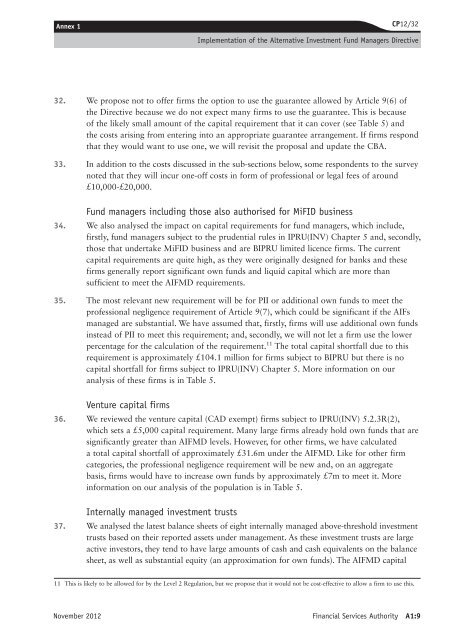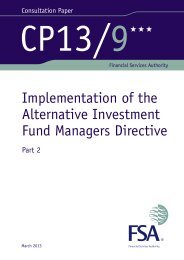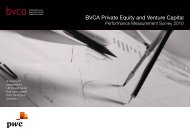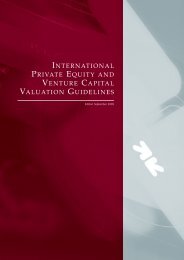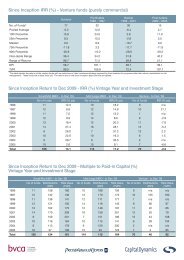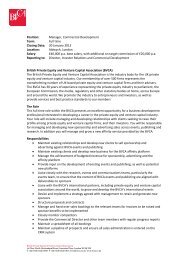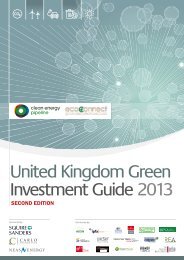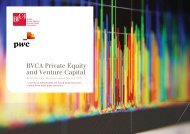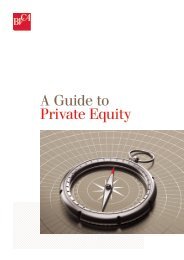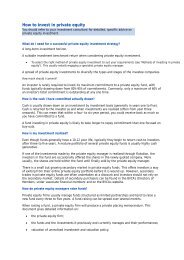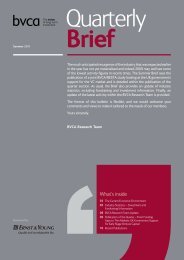CP12/32: Implementation of the Alternative ... - BVCA admin
CP12/32: Implementation of the Alternative ... - BVCA admin
CP12/32: Implementation of the Alternative ... - BVCA admin
Create successful ePaper yourself
Turn your PDF publications into a flip-book with our unique Google optimized e-Paper software.
Annex 1<br />
November 2012<br />
<strong>CP12</strong>/<strong>32</strong><br />
<strong>Implementation</strong> <strong>of</strong> <strong>the</strong> <strong>Alternative</strong> Investment Fund Managers Directive<br />
<strong>32</strong>. We propose not to <strong>of</strong>fer firms <strong>the</strong> option to use <strong>the</strong> guarantee allowed by Article 9(6) <strong>of</strong><br />
<strong>the</strong> Directive because we do not expect many firms to use <strong>the</strong> guarantee. This is because<br />
<strong>of</strong> <strong>the</strong> likely small amount <strong>of</strong> <strong>the</strong> capital requirement that it can cover (see Table 5) and<br />
<strong>the</strong> costs arising from entering into an appropriate guarantee arrangement. If firms respond<br />
that <strong>the</strong>y would want to use one, we will revisit <strong>the</strong> proposal and update <strong>the</strong> CBA.<br />
33. In addition to <strong>the</strong> costs discussed in <strong>the</strong> sub-sections below, some respondents to <strong>the</strong> survey<br />
noted that <strong>the</strong>y will incur one-<strong>of</strong>f costs in form <strong>of</strong> pr<strong>of</strong>essional or legal fees <strong>of</strong> around<br />
£10,000-£20,000.<br />
Fund managers including those also authorised for MiFID business<br />
34. We also analysed <strong>the</strong> impact on capital requirements for fund managers, which include,<br />
firstly, fund managers subject to <strong>the</strong> prudential rules in IPRU(INV) Chapter 5 and, secondly,<br />
those that undertake MiFID business and are BIPRU limited licence firms. The current<br />
capital requirements are quite high, as <strong>the</strong>y were originally designed for banks and <strong>the</strong>se<br />
firms generally report significant own funds and liquid capital which are more than<br />
sufficient to meet <strong>the</strong> AIFMD requirements.<br />
35. The most relevant new requirement will be for PII or additional own funds to meet <strong>the</strong><br />
pr<strong>of</strong>essional negligence requirement <strong>of</strong> Article 9(7), which could be significant if <strong>the</strong> AIFs<br />
managed are substantial. We have assumed that, firstly, firms will use additional own funds<br />
instead <strong>of</strong> PII to meet this requirement; and, secondly, we will not let a firm use <strong>the</strong> lower<br />
percentage for <strong>the</strong> calculation <strong>of</strong> <strong>the</strong> requirement. 11 The total capital shortfall due to this<br />
requirement is approximately £104.1 million for firms subject to BIPRU but <strong>the</strong>re is no<br />
capital shortfall for firms subject to IPRU(INV) Chapter 5. More information on our<br />
analysis <strong>of</strong> <strong>the</strong>se firms is in Table 5.<br />
Venture capital firms<br />
36. We reviewed <strong>the</strong> venture capital (CAD exempt) firms subject to IPRU(INV) 5.2.3R(2),<br />
which sets a £5,000 capital requirement. Many large firms already hold own funds that are<br />
significantly greater than AIFMD levels. However, for o<strong>the</strong>r firms, we have calculated<br />
a total capital shortfall <strong>of</strong> approximately £31.6m under <strong>the</strong> AIFMD. Like for o<strong>the</strong>r firm<br />
categories, <strong>the</strong> pr<strong>of</strong>essional negligence requirement will be new and, on an aggregate<br />
basis, firms would have to increase own funds by approximately £7m to meet it. More<br />
information on our analysis <strong>of</strong> <strong>the</strong> population is in Table 5.<br />
Internally managed investment trusts<br />
37. We analysed <strong>the</strong> latest balance sheets <strong>of</strong> eight internally managed above-threshold investment<br />
trusts based on <strong>the</strong>ir reported assets under management. As <strong>the</strong>se investment trusts are large<br />
active investors, <strong>the</strong>y tend to have large amounts <strong>of</strong> cash and cash equivalents on <strong>the</strong> balance<br />
sheet, as well as substantial equity (an approximation for own funds). The AIFMD capital<br />
11 This is likely to be allowed for by <strong>the</strong> Level 2 Regulation, but we propose that it would not be cost-effective to allow a firm to use this.<br />
Financial Services Authority A1:9


